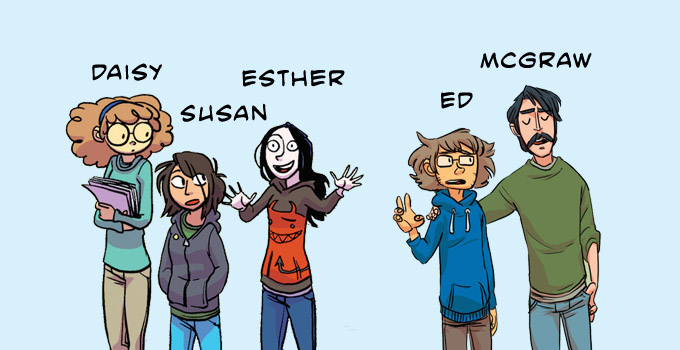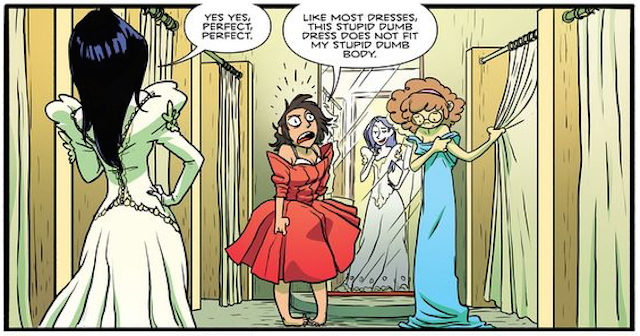My mother once asked me, “Why do we pursue higher education?” The question wasn’t about my own reasons, but rather the greater meaning.
“To get a job,” I said, more or less confident in my answer.
“No,” she replied. “We go to college to grow, to become more well-rounded members of society – it’s not the only route by any means, but if that’s the path you choose, it’s important to know why.” The point of college isn’t to earn a degree to find a job – that’s a big part of the experience, but not the focus.
College is meant to provide students with a chance to gain wisdom from differing perspectives, to step outside your own world and experience a much larger one. Meeting new people, engaging in new activities, and learning new ideas are the pillars of higher education, the driving forces that make college/university worth the effort.
John Allison and Max Sarin’s Giant Days from BOOM! Studios is a seminal foray into the lives of three university students who meet as freshmen roommates and grow into fast friends. The series deconstructs higher education archetypes into relatable and familiar narratives about personal growth, friendship, and the navigation of emotional obstacles.

In the vein of French creator Diglee’s phenomenal Forever Bitch, the nuances surrounding Susan, Esther, and Daisy’s friendship are undeniably connected to the visual aesthetic, a symbiosis of the written and visual few comics achieve on a consistent basis. Sarin’s emotive cartooning combined with Allison’s dry wit exemplifies the medium and should be regarded as a high-water mark for the art form.
Even the title, Giant Days, evokes the feelings of being a college student, when nothing can go wrong and the whole world is simply waiting for you to come and take what you want, when you feel like a giant because your life from before seems so small compared to what comes next, when you’re empowered by the expansion of your own horizons because each new day is a new adventure.
Not everyone has the means to attend college, and not everyone considers higher education a worthy endeavor. The latter opinion is unfortunate insomuch as Giant Days aims to inform as much as entertain, to provide a generally realistic glance into the ups and downs of university life and how those experiences can affect perspective.
Because of course, Giant Days isn’t limited to the goings on of just Susan, Esther, and Daisy. The supporting cast is integral to the fabric of this series, which might sound like common sense if this dynamic wasn’t so hard to find in most superhero fare. And while Giant Days is by no means a superhero comic book, any story with a fully developed cast of secondary characters is better because it gives readers more reasons to care – even if you love to hate Susan, you might relate to Ed or McGraw.
Dramedy today is often drama with spats of humor as opposed to the inversion John Allison creates in Giant Days through a steady stream of humor with purposely paced drama as an emotional anchor. Esther’s charmingly egotistical behavior starts to make sense when considering her family dynamic; Susan’s hilariously public inner turmoil stems from her unabashed independence and stubbornness; Daisy’s about as naïve as they come, her awkward cuteness a byproduct of a sheltered upbringing by her kindly grandmother. All three girls have something to prove, whether to themselves or others, and relatable drama borne from comedic situations has become the bedrock of this title’s narrative draw.
DC and Marvel often pair writers and artists together based on metrics other than creative cohesion – writers tend to guide the ship while artists build around the script. Friction between the words and art in a comic can break the entire experience and leave readers feeling disconnected and frustrated. That said, the ‘indie’ sector (Image, Dark Horse, Dynamite, of course BOOM, etc.) understands the value in a coherent creative team that can take a comic book from great to exceptional – look no further than Tom King and Gabriel Hernandez-Walta’s The Vision for evidence to theory.

In an industry with such visual and graphic diversity, ‘cartoonish’ is a classification of comic book art often frowned upon, which is odd considering the medium was once dominated by lighthearted, cartoony fare more so than superhero house styles or genre-specific aesthetic. Giant Days is a cartoonish book – there’s no question about that – and Max Sarin’s artwork is what makes the book work as well as it does.
The norm for animated programming typically involves voice actors recording their lines separately to be edited together in postproduction. This norm for animation compares to the aforementioned development process for mainstream comics (writer provides artist with script, “edited” together in final stages). The cast of FOX’s Bob’s Burgers record together in sessions as a way to create more believably humorous interactions. Similarly, Allison and Sarin have a working relationship wherein their output feeds into each another almost seamlessly.
A lip movement perfectly fits the cutesy pronunciation of “lerv”; a specific eye roll conveys the perfect balance of snark and hurt; personified drama clouds over the perpetrator; a misguided hug looks as awkward as it must feel. When considered through an analytical lens, all of these nuanced moments in Giant Days create trees in the forest, small instances of depth hiding in plain sight that each add to the story’s emotional weight.
Giant Days is a shining beacon to the tenet of symbiosis; a textbook example of how a writer and artist can work together with clear direction and focused intention. Allison and Sarin are by no means the first duo to reach this level of synergy (Kieron Gillen and Jamie McKelvie, Grant Morrison and Frank Quitely, Denny O’Neil and Neal Adams), but they do give nearly everyone else a run for their money in regards to effect.
Which brings me back to college (not literally, though it might be fun to have another go.) There is no right or wrong way to ‘do’ higher education. Giant Days makes this clear: everyone’s experience is different. Some go the super-studier route while others drink themselves into a stupor for four years. Some find a good balance between classes and social life while lose themselves in the chaos. Some coast through their studies with natural adeptness while others work hard for every passing grade.
Each character in Giant Days comes with his or her own baggage and skills, the flaws and the strengths that define us as human beings. If you were the big fish in a small hometown pond who became a much smaller catch, Esther’s journey through her own hyper-confidence might mirror your experience. If leaving for college was the first time you left your home state (or county), Daisy’s wide-eyed enthusiasm might speak to your own optimism for the future. If you’re cynical to the world and have the emotional scars to prove it, Susan’s self-reliance and dedication to her values will feel relatable.
More than most titles on the stands today (or any day), John Allison and Max Sarin’s Giant Days stands a testament to the college experience, the comic book medium, and storytelling as an art form.